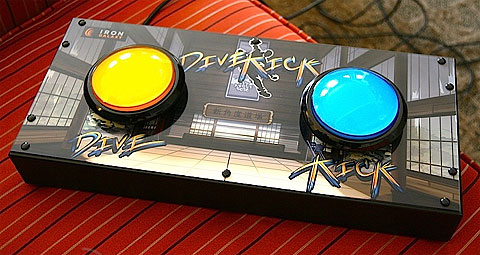By Joel Smart (The Cascade) – Email
Print Edition: April 10, 2013
Have you ever tried to play a game only to become bogged down with the complex control scheme?
Maybe it was a game with intense controls—like a sports game, a real time strategy game or a role playing game—or a game that relies on heavy memorization of “moves” like a fighting game. If so, you’re not the only one. More and more, game designers are looking into alternative control schemes to make them more accessible – and more compelling.
For Adam Hearts and his friend Steve, the solution arose as joke in the middle of the night – a fighting game controlled with just two buttons. The objective, to jump into the air (with one button) and then do a diving kick (with the other). By pressing that latter button when you’re on the ground, your character will dodge away from their opponent. Those are the only controls in their upcoming game, Divekick, coming to PSN this summer. There are no complex combo moves where players need to press “up, up, right, down” to deliver the killing blow, and therefore no need for inexperienced players to mash the buttons in an attempt to outwit their more practiced friends.
Yet the gameplay remains competitive and strategy more apparent than ever – especially since it takes just one connecting dive-kick to win a round (and five rounds to win the match). While the game also features a kick metre that, when filled, allows players to press both buttons at the same time to perform “special moves,” these appear not to be the main focus of the game and can be turned off if players prefer the game in its more minimalist form.
Many games in the past have used primarily two buttons. Early games were often designed to function with a “dial” and a single button. Pong functions simply with a dial. However, many of these games were constrained by the hardware available at the time, rather than the deliberate choices of a designer. It’s this thoughtfulness that intrigues me about Divekick.
It reminds me of an intriguing Gamasutra article from 2005 called “One Button Games” that delved deeply into the potential uses of a single button to control a game. For movement, a button press could move a player and releasing it could stop. Or, a press could move the player right and releasing the button could move the player left. Or, pressing the button could move the player to one position (a) and releasing it could move the player to another position (b). Included in this could be that the player rotates when the button is released; this could allow a single button to control, for example, a tank that turns when it stops, allowing the player to wait until the tank is facing the direction they want to go before pressing the gas button again.
The same article also used examples of different ways a single button can be used to allow a player to jump – citing six main examples. At the most basic, a player presses the button and a jump occurs, with nothing happening differently when the button is released (Donkey Kong). As the article moves through the six levels, the complexity increases. Releasing the jump button can trigger the character to fall faster the floor, or it can allow the button to be pressed again for a double jump (Super Smash Bros., Castlevania, Devil May Cry, God of War). There are even games that allow you to hold the jump button for varying purposes – either to add additional height to a jump the longer you hold it (Mario), or to allow you to “charge” your jump for more height which only occurs when you release the jump button (Spiderman).
Although this might sound complex, the point is that a single button can make a big difference. As game designers find the space to be more creative, they can experiment and refine their control schemes.
While some games will always rely on numerous buttons, there is something exciting about a game that dares to strip away the distractions and complexities, focusing instead on doing one thing really well.


